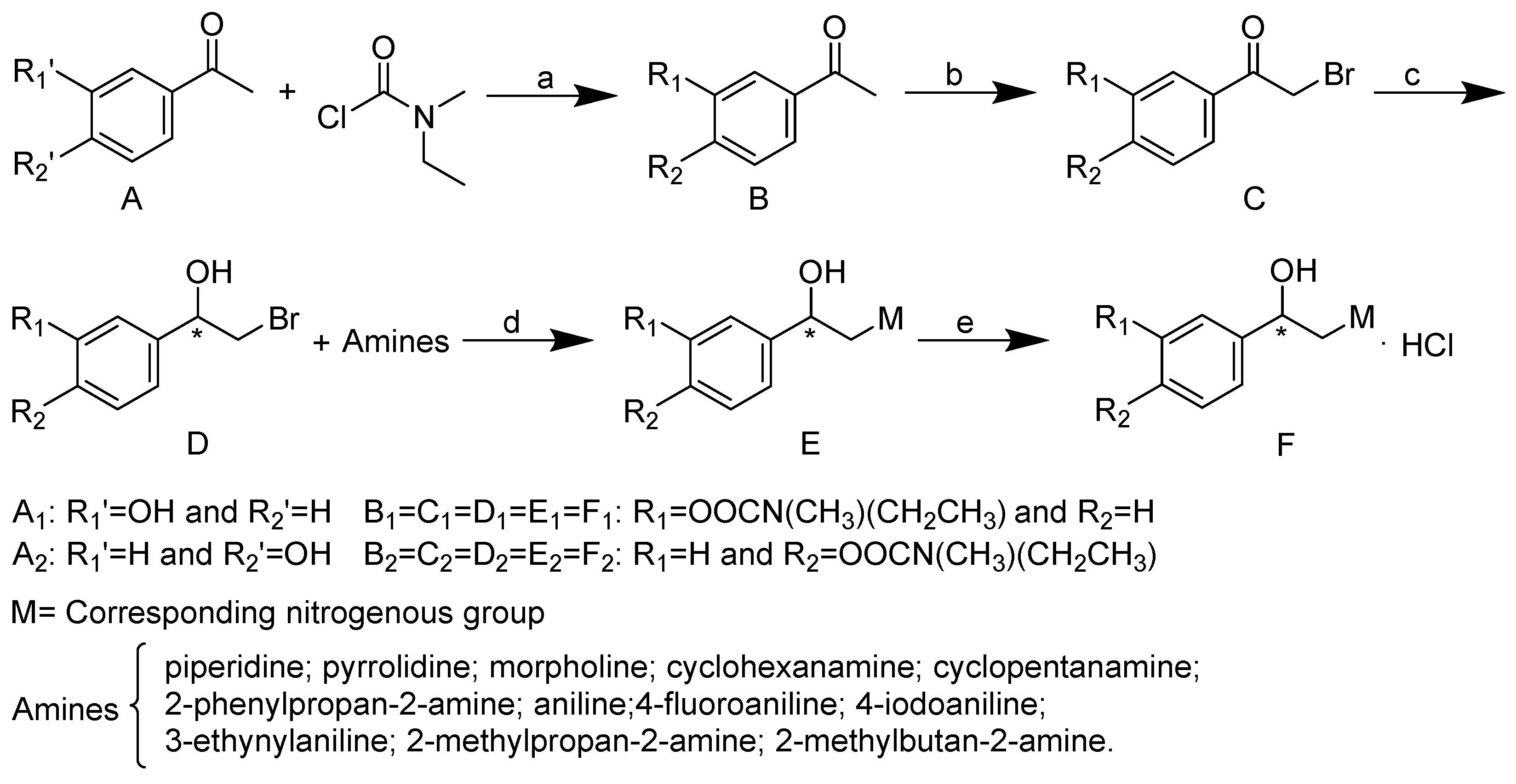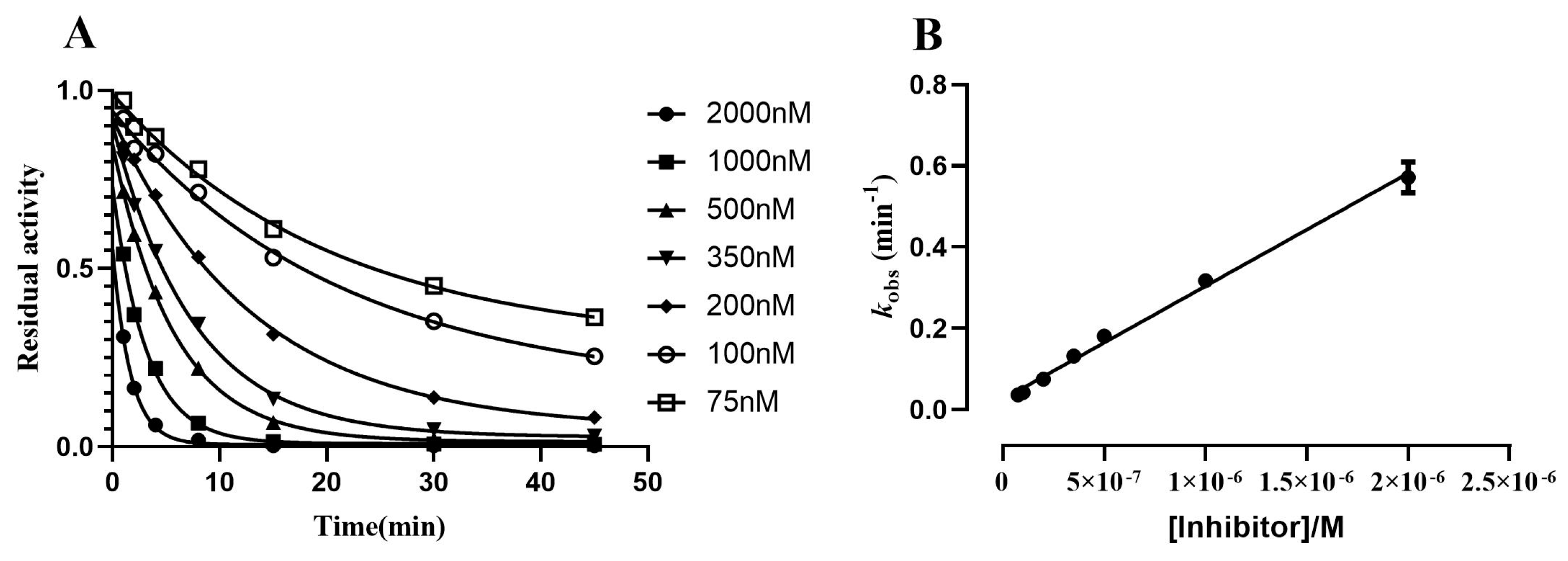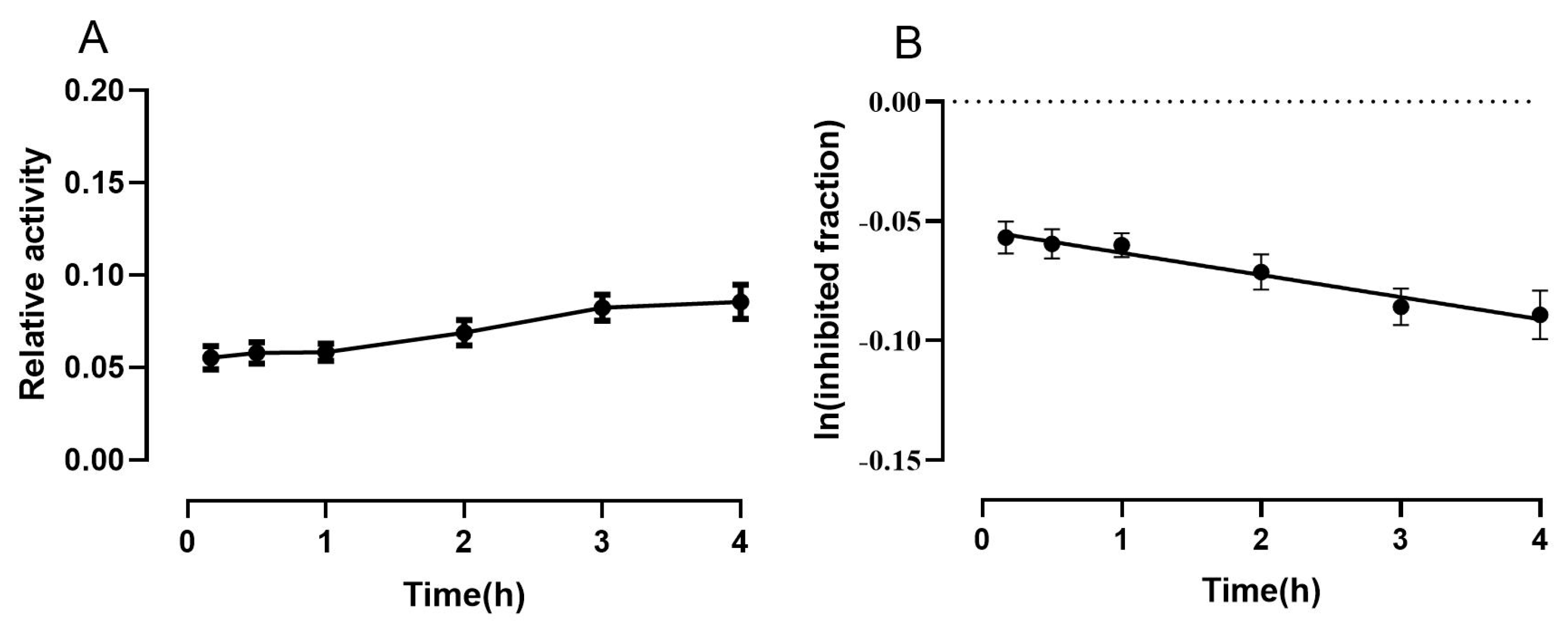Rivastigmine–Bambuterol Hybrids as Selective Butyrylcholinesterase Inhibitors
Abstract
:1. Introduction
2. Results and Discussion
2.1. Chemistry
2.2. Measurement of IC50
2.3. In Silico Chemical Analysis of Molecular Properties
2.4. Kinetic Study of the Inhibition of eqBChE by MTR-3
2.5. Determination of the Decarbamylation Rate Constants of N-Methyl-N-ethyl-eqBChE, k3
3. Materials and Methods
3.1. Chemistry
3.2. General Procedures for the Preparation of Carbamates
3.2.1. Method 1: Preparation of Compounds without Salt Formation (MTR-3 to MTR-15)
3.2.2. Method 2: Preparation of MTR-1 and MTR-2 as Hydrochloride Salts
3.2.3. 3-(2-(Tert-butylamino)-1-hydroxyethyl)phenyl ethyl(methyl)carbamate Hydrochloride (MTR-1)
3.2.4. 3-(1-Hydroxy-2-(tert-pentylamino)ethyl)phenyl Ethyl(methyl)carbamate hydrochloride (MTR-2)
3.2.5. 3-(1-Hydroxy-2-(piperidin-1-yl)ethyl)phenyl Ethyl(methyl)carbamate (MTR-3)
3.2.6. 3-(2-(Cyclohexylamino)-1-hydroxyethyl)phenyl Ethyl(methyl)carbamate (MTR-4)
3.2.7. 3-(2-(Cyclopentylamino)-1-hydroxyethyl)phenyl Ethyl(methyl)carbamate (MTR-5)
3.2.8. 3-(1-Hydroxy-2-morpholinoethyl)phenyl Ethyl(methyl)carbamate (MTR-6)
3.2.9. 3-(1-Hydroxy-2-(pyrrolidin-1-yl)ethyl)phenyl Ethyl(methyl)carbamate (MTR-7)
3.2.10. 3-(1-Hydroxy-2-(phenylamino)ethyl)phenyl Ethyl(methyl)carbamate (MTR-8)
3.2.11. 3-(1-Hydroxy-2-((4-iodophenyl)amino)ethyl)phenyl Ethyl(methyl)carbamate (MTR-9)
3.2.12. 3-(2-((4-Fluorophenyl)amino)-1-hydroxyethyl)phenyl Ethyl(methyl)carbamate (MTR-10)
3.2.13. 3-(1-Hydroxy-2-((2-phenylpropan-2-yl)amino)ethyl)phenyl Ethyl(methyl)carbamate (MTR-11)
3.2.14. 3-(2-((3-Ethynylphenyl)amino)-1-hydroxyethyl)phenyl Ethyl(methyl)carbamate (MTR-12)
3.2.15. 4-(2-(Tert-butylamino)-1-hydroxyethyl)phenyl Ethyl(methyl)carbamate (MTR-13)
3.2.16. 4-(1-Hydroxy-2-(tert-pentylamino)ethyl)phenyl Ethyl(methyl)carbamate (MTR-14)
3.2.17. 4-(1-Hydroxy-2-(piperidin-1-yl)ethyl)phenyl Ethyl(methyl)carbamate (MTR-15)
3.3. Measurement of ChE Activity
3.3.1. Ellman’s Assay with Modification
3.3.2. Determination of IC50 Values
3.3.3. Determination of kI Using eqBChE and MTR-3
3.3.4. Determination of k3 Using eqBChE and MTR-3
3.4. Prediction of Molecular Properties
4. Conclusions
Author Contributions
Funding
Institutional Review Board Statement
Informed Consent Statement
Data Availability Statement
Conflicts of Interest
References
- Bajda, M.; Latka, K.; Hebda, M.; Jonczyk, J.; Malawska, B. Novel carbamate derivatives as selective butyrylcholinesterase inhibitors. Bioorganic Chem. 2018, 78, 29–38. [Google Scholar] [CrossRef] [PubMed]
- Abedinifar, F.; Farnia, S.M.F.; Mahdavi, M.; Nadri, H.; Moradi, A.; Ghasemi, J.B.; Küçükkılınç, T.T.; Firoozpour, L.; Foroumadi, A. Synthesis and cholinesterase inhibitory activity of new 2-benzofuran carboxamide-benzylpyridinum salts. Bioorganic Chem. 2018, 80, 180–188. [Google Scholar] [CrossRef] [PubMed]
- Wu, C.; Tu, Y.B.; Li, Z.; Li, Y.F. Highly selective carbamate-based butyrylcholinesterase inhibitors derived from a naturally occurring pyranoisoflavone. Bioorganic Chem. 2019, 88, 102949. [Google Scholar] [CrossRef] [PubMed]
- Giacobini, E. Cholinergic function and Alzheimer’s disease. Int. J. Geriatr. Psychiatry 2003, 18 (Suppl. 1), S1–S5. [Google Scholar] [CrossRef] [PubMed]
- Ghobadian, R.; Nadri, H.; Moradi, A.; Bukhari, S.N.A.; Mahdavi, M.; Asadi, M.; Akbarzadeh, T.; Khaleghzadeh-Ahangar, H.; Sharifzadeh, M.; Amini, M. Design, synthesis, and biological evaluation of selective and potent Carbazole-based butyrylcholinesterase inhibitors. Bioorganic Med. Chem. 2018, 26, 4952–4962. [Google Scholar] [CrossRef]
- Kandiah, N.; Pai, M.C.; Senanarong, V.; Looi, I.; Ampil, E.; Park, K.W.; Karanam, A.K.; Christopher, S. Rivastigmine: The advantages of dual inhibition of acetylcholinesterase and butyrylcholinesterase and its role in subcortical vascular dementia and Parkinson’s disease dementia. Clin. Interv. Aging 2017, 12, 697–707. [Google Scholar] [CrossRef]
- Bacalhau, P.; San Juan, A.A.; Goth, A.; Caldeira, A.T.; Martins, R.; Burke, A.J. Insights into (S)-rivastigmine inhibition of butyrylcholinesterase (BuChE): Molecular docking and saturation transfer difference NMR (STD-NMR). Bioorganic Chem. 2016, 67, 105–109. [Google Scholar] [CrossRef]
- Pistolozzi, M.; Du, H.; Wei, H.; Tan, W. Stereoselective inhibition of human butyrylcholinesterase by the enantiomers of bambuterol and their intermediates. Drug Metab. Dispos. Biol. Fate Chem. 2015, 43, 344–352. [Google Scholar] [CrossRef]
- Tunek, A.; Svensson, L.A. Bambuterol, a carbamate ester prodrug of terbutaline, as inhibitor of cholinesterases in human blood. Drug Metab. Dispos. Biol. Fate Chem. 1988, 16, 759–764. [Google Scholar]
- Kovarik, Z.; Radic, Z.; Grgas, B.; Skrinjaric-Spoljar, M.; Reiner, E.; Simeon-Rudolf, V. Amino acid residues involved in the interaction of acetylcholinesterase and butyrylcholinesterase with the carbamates Ro 02-0683 and bambuterol, and with terbutaline. Biochim. Biophys. Acta 1999, 1433, 261–271. [Google Scholar] [CrossRef]
- Bosak, A.; Gazic Smilovic, I.; Sinko, G.; Vinkovic, V.; Kovarik, Z. Metaproterenol, isoproterenol, and their bisdimethylcarbamate derivatives as human cholinesterase inhibitors. J. Med. Chem. 2012, 55, 6716–6723. [Google Scholar] [CrossRef]
- Wu, J.; Tian, Y.; Wang, S.; Pistolozzi, M.; Jin, Y.; Zhou, T.; Roy, G.; Xu, L.; Tan, W. Design, synthesis and biological evaluation of bambuterol analogues as novel inhibitors of butyrylcholinesterase. Eur. J. Med. Chem. 2017, 126, 61–71. [Google Scholar] [CrossRef]
- Wu, J.; Pistolozzi, M.; Liu, S.; Tan, W. Design, synthesis and biological evaluation of novel carbamates as potential inhibitors of acetylcholinesterase and butyrylcholinesterase. Bioorganic Med. Chem. 2020, 28, 115324. [Google Scholar] [CrossRef]
- Xu, Y.; Jian, M.M.; Han, C.; Yang, K.; Bai, L.G.; Cao, F.; Ma, Z.Y. Design, synthesis and evaluation of new 4-arylthiazole-2-amine derivatives as acetylcholinesterase inhibitors. Bioorganic Med. Chem. Lett. 2020, 30, 126985. [Google Scholar] [CrossRef]
- Hitchcock, S.A.; Pennington, L.D. Structure-brain exposure relationships. J. Med. Chem. 2006, 49, 7559–7583. [Google Scholar] [CrossRef]
- Prinz, M.; Parlar, S.; Bayraktar, G.; Alptüzün, V.; Erciyas, E.; Fallarero, A.; Karlsson, D.; Vuorela, P.; Burek, M.; Förster, C.; et al. 1,4-Substituted 4-(1H)-pyridylene-hydrazone-type inhibitors of AChE, BuChE, and amyloid-β aggregation crossing the blood-brain barrier. Eur. J. Pharm. Sci. Off. J. Eur. Fed. Pharm. Sci. 2013, 49, 603–613. [Google Scholar] [CrossRef]
- Skrzypek, A.; Matysiak, J.; Niewiadomy, A.; Bajda, M.; Szymański, P. Synthesis and biological evaluation of 1,3,4-thiadiazole analogues as novel AChE and BuChE inhibitors. Eur. J. Med. Chem. 2013, 62, 311–319. [Google Scholar] [CrossRef]
- Lipinski, C.A.; Lombardo, F.; Dominy, B.W.; Feeney, P.J. Experimental and computational approaches to estimate solubility and permeability in drug discovery and development settings. Adv. Drug Deliv. Rev. 2012, 64, 4–17. [Google Scholar] [CrossRef]
- Venkatasubban, K.S.; Johnson, J.L.; Thomas, J.L.; Fauq, A.; Cusack, B.; Rosenberry, T.L. Decarbamoylation of acetylcholinesterases is markedly slowed as carbamoyl groups increase in size. Arch. Biochem. Biophys. 2018, 655, 67–74. [Google Scholar] [CrossRef]
- Perola, E.; Cellai, L.; Lamba, D.; Filocamo, L.; Brufani, M. Long chain analogs of physostigmine as potential drugs for Alzheimer’s disease: New insights into the mechanism of action in the inhibition of acetylcholinesterase. Biochim. Biophys. Acta 1997, 1343, 41–50. [Google Scholar] [CrossRef]
- Groner, E.; Ashani, Y.; Schorer-Apelbaum, D.; Sterling, J.; Herzig, Y.; Weinstock, M. The kinetics of inhibition of human acetylcholinesterase and butyrylcholinesterase by two series of novel carbamates. Mol. Pharmacol. 2007, 71, 1610–1617. [Google Scholar] [CrossRef] [PubMed]
- Ellman, G.L.; Courtney, K.D.; Andres, V.; Feather-Stone, R.M., Jr. A new and rapid colorimetric determination of acetylcholinesterase activity. Biochem. Pharmacol. 1961, 7, 88–95. [Google Scholar] [CrossRef] [PubMed]




 | |||||
|---|---|---|---|---|---|
| Compound | R1 | R2 | M | elAChE IC50 a Mean ± SD (μM) | eqBChE IC50 a Mean ± SD (μM) |
| Rivastigmine | 23 ± 5 b | 0.79 ± 0.06 b | |||
| Bambuterol | >100 c | 0.119 ± 0.004 c | |||
| MTR-1 | OOCN(CH3)(CH2CH3) | H |  | >100 | 0.37 ± 0.02 |
| MTR-2 | OOCN(CH3)(CH2CH3) | H |  | >100 | 0.17 ± 0.01 |
| MTR-3 | OOCN(CH3)(CH2CH3) | H |  | >100 | 0.078 ± 0.005 |
| MTR-4 | OOCN(CH3)(CH2CH3) | H |  | 79 ± 4 | 0.0090 ± 0.0004 |
| MTR-5 | OOCN(CH3)(CH2CH3) | H |  | 92 ± 7 | 0.074 ± 0.005 |
| MTR-6 | OOCN(CH3)(CH2CH3) | H |  | >100 | 2.5 ± 0.2 |
| MTR-7 | OOCN(CH3)(CH2CH3) | H |  | 78.9 ± 0.9 | 0.21 ± 0.01 |
| MTR-8 | OOCN(CH3)(CH2CH3) | H |  | >100 | 0.32 ± 0.02 |
| MTR-9 | OOCN(CH3)(CH2CH3) | H |  | >100 | 1.73 ± 0.05 |
| MTR-10 | OOCN(CH3)(CH2CH3) | H |  | >100 | 0.192 ± 0.007 |
| MTR-11 | OOCN(CH3)(CH2CH3) | H |  | >100 | 0.323 ± 0.008 |
| MTR-12 | OOCN(CH3)(CH2CH3) | H |  | >100 | 0.156 ± 0.007 |
| MTR-13 | H | OOCN(CH3)(CH2CH3) |  | >100 | 8.7 ± 0.3 |
| MTR-14 | H | OOCN(CH3)(CH2CH3) |  | >100 | 1.7 ± 0.1 |
| MTR-15 | H | OOCN(CH3)(CH2CH3) |  | 59 ± 16 | 0.42 ± 0.02 |
| Code | MW | MiLogP | HBA | HBD | nviolations | nROT | TPSA (Å2) | Volume |
|---|---|---|---|---|---|---|---|---|
| Rule | <500 | ≤5 | ≤10 | ≤5 | ≤1 | - | ≤70 | - |
| Rivastigmine | 250.34 | 2.28 | 4 | 0 | 0 | 5 | 32.78 | 254.01 |
| MTR-1 | 294.39 | 2.07 | 5 | 2 | 0 | 7 | 61.80 | 294.96 |
| MTR-2 | 308.42 | 2.58 | 5 | 2 | 0 | 8 | 61.80 | 311.76 |
| MTR-3 | 306.41 | 2.04 | 5 | 1 | 0 | 6 | 53.01 | 302.32 |
| MTR-4 | 320.43 | 2.79 | 5 | 2 | 0 | 7 | 61.80 | 318.76 |
| MTR-5 | 306.41 | 2.29 | 5 | 2 | 0 | 7 | 61.80 | 301.96 |
| MTR-6 | 308.38 | 0.98 | 6 | 1 | 0 | 6 | 62.24 | 294.50 |
| MTR-7 | 292.38 | 1.53 | 5 | 1 | 0 | 6 | 53.01 | 285.52 |
| MTR-8 | 314.38 | 2.58 | 5 | 2 | 0 | 7 | 61.80 | 300.18 |
| MTR-9 | 440.28 | 3.67 | 5 | 2 | 0 | 7 | 61.80 | 324.17 |
| MTR-10 | 332.38 | 2.75 | 5 | 2 | 0 | 7 | 61.80 | 305.11 |
| MTR-11 | 356.47 | 3.29 | 5 | 2 | 0 | 8 | 61.80 | 349.80 |
| MTR-12 | 338.41 | 2.32 | 5 | 2 | 0 | 7 | 61.80 | 322.44 |
| MTR-13 | 294.39 | 2.10 | 5 | 2 | 0 | 7 | 61.80 | 294.96 |
| MTR-14 | 308.42 | 2.60 | 5 | 2 | 0 | 8 | 61.80 | 311.76 |
| MTR-15 | 306.41 | 2.06 | 5 | 1 | 0 | 6 | 53.01 | 302.32 |
| Compound and Enzyme | kI (×105 M−1 min−1) Mean ± SD | k3 (×h−1) Mean ± SD |
|---|---|---|
| MTR-3-eqBChE | 2.78 ± 0.15 | 0.0093 ± 0.0010 |
| Bambuterol-eqBChE | 1.44 ± 0.02 a | 0.0839 ± 0.0028 a |
Disclaimer/Publisher’s Note: The statements, opinions and data contained in all publications are solely those of the individual author(s) and contributor(s) and not of MDPI and/or the editor(s). MDPI and/or the editor(s) disclaim responsibility for any injury to people or property resulting from any ideas, methods, instructions or products referred to in the content. |
© 2023 by the authors. Licensee MDPI, Basel, Switzerland. This article is an open access article distributed under the terms and conditions of the Creative Commons Attribution (CC BY) license (https://creativecommons.org/licenses/by/4.0/).
Share and Cite
Wu, J.; Tan, Z.; Pistolozzi, M.; Tan, W. Rivastigmine–Bambuterol Hybrids as Selective Butyrylcholinesterase Inhibitors. Molecules 2024, 29, 72. https://doi.org/10.3390/molecules29010072
Wu J, Tan Z, Pistolozzi M, Tan W. Rivastigmine–Bambuterol Hybrids as Selective Butyrylcholinesterase Inhibitors. Molecules. 2024; 29(1):72. https://doi.org/10.3390/molecules29010072
Chicago/Turabian StyleWu, Jie, Zekai Tan, Marco Pistolozzi, and Wen Tan. 2024. "Rivastigmine–Bambuterol Hybrids as Selective Butyrylcholinesterase Inhibitors" Molecules 29, no. 1: 72. https://doi.org/10.3390/molecules29010072
APA StyleWu, J., Tan, Z., Pistolozzi, M., & Tan, W. (2024). Rivastigmine–Bambuterol Hybrids as Selective Butyrylcholinesterase Inhibitors. Molecules, 29(1), 72. https://doi.org/10.3390/molecules29010072






